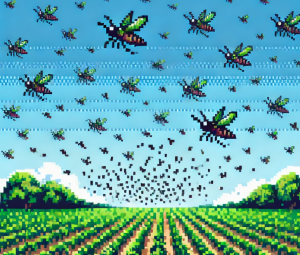
Unveiling Nature’s Map: How Butterflies Hold the Key to Climate’s Genetic Legacy
Imagine you’re hiking in the Alps, taking in the crisp mountain air, when a butterfly flits by. What if I told you that tiny creature carries a map—an ancient one, written not on paper, but in its genes? This map traces climate change over millennia, revealing the genetic story of survival, adaptation, and movement. Today, thanks to an astonishing dataset of 31,653 butterfly DNA sequences, scientists have pieced together a massive puzzle about how climate has shaped biodiversity. And this discovery could help us predict and protect life in the face of our current climate crisis.
The Genetic Blueprint of Survival
Our planet has experienced countless ice ages, times when glaciers stretched across continents and only the hardiest species survived in isolated patches of land known as refugia. These refugia acted as life-saving havens, where species like butterflies hunkered down, waiting out the cold. When the ice retreated, the butterflies expanded into new territories, and the process repeated with each climatic pulse. Over thousands of years, these expansions left a genetic fingerprint in the butterflies that remains today. This fingerprint is what scientists call the Genetic Legacy of the Quaternary (GLQ) period.
But why should we care about the genetic patterns of butterflies? Because they tell us a lot about how species respond to climate change. By studying the way butterflies survived and moved during past climate shifts, we can better understand what might happen to today’s animals—including us—as global temperatures rise again.
Real-World Impacts Hidden in Wings
Let’s break down the science.
Researchers took a detailed look at the mitochondrial DNA of butterflies across the Western Palearctic region, which includes parts of Europe, North Africa, and Asia. They focused on a section of the DNA called Cytochrome c oxidase subunit 1 (COI), a marker used to understand genetic diversity. From this, they identified seven distinct biogeographic regions, each shaped by different climate events. These regions, like the Maghreb in North Africa and the Balkans in Southeastern Europe, have their own unique genetic make-up, reflecting how butterflies survived in these areas during past ice ages.
One of the most fascinating findings was that mountain ranges and sea straits acted as powerful barriers to butterfly movement. Think of the Alps, Pyrenees, and even the Mediterranean Sea as invisible fences, shaping the genetic pools of these fluttering creatures. Butterflies with shorter flight periods, for example, are more likely to be genetically unique to certain regions because they don’t travel as far, making them perfect subjects to study how genetic diversity varies across landscapes.
A Genetic Time Machine
Now, let’s hop into a time machine. Imagine traveling back 20,000 years to the last ice age. Europe was a vastly different place, covered in glaciers, with only a few areas warm enough to sustain life. Butterflies clustered in these refugia, developing distinct genetic lineages over time. As the glaciers melted, the butterflies spread northward, carrying their unique genes with them. This recolonization process led to what’s known as the “southern richness-northern purity” trend, where species in the south are more genetically diverse than those in the north.
Why is this important? It’s like watching evolution in action. By studying their genetic diversity, we can see how species adapted to past climate changes. This knowledge is crucial now because today’s warming climate may force species to move and adapt all over again, just as they did during the ice ages.
Hotspots of Biodiversity Under Threat
The study also identified genetic hotspots—regions where butterflies have the highest levels of genetic diversity. Unsurprisingly, these hotspots are in the Mediterranean, a region known for its biodiversity. But here’s the catch: many of these hotspots, particularly in North Africa and southern Europe, are also areas facing the most intense human pressure. Overgrazing, habitat loss, and climate change are putting these genetically unique populations at risk.
Consider the Maghreb, one of the most genetically diverse areas for butterflies but also one of the most vulnerable to climate change. If these populations disappear, we could lose entire branches of the butterfly family tree and the genetic clues they hold about our planet’s past and future.
A Modern-Day Lesson in Adaptation
What can we learn from this butterfly research? A lot. For one, we see that species aren’t just passively shaped by climate—they actively adapt. Butterflies didn’t just survive the ice ages; they evolved, finding ways to thrive in new environments. This adaptability is a critical lesson for today, as modern species face new challenges from climate change.
But adaptation has its limits. The current rate of climate change is much faster than anything the world’s butterflies—or any other species—have ever faced. While the past offers clues about how life can survive major shifts, it also underscores the importance of protecting biodiversity today. We need to safeguard the regions that house these genetic hotspots, not only for butterflies but for all species that depend on these ecosystems.
Join the Conversation
What other species do you think hold hidden clues to surviving climate change? And how do you think we can balance the need for development with the preservation of biodiversity hotspots like the Mediterranean?
Unlock Science Secrets
Discover revolutionary research and innovative discoveries with ‘This Week in Science’! Designed for educators and science lovers, our free weekly newsletter offers insights that can transform your approach to science. Sign up now and deepen your understanding and passion for science. If you liked this blog, please share it! Your referrals help This Week in Science reach new readers.



